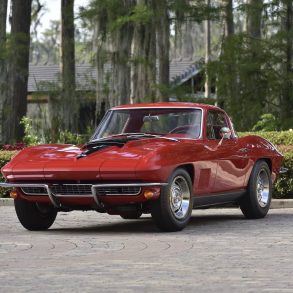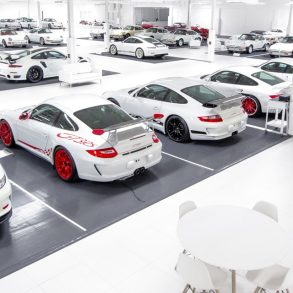By Will Silk

The Allard J2X marked the high water mark for the Allard marque when it first appeared in 1951 as an evolution of the Allard J2. Sydney Herbert Allard started out racing motorcycles and Morgan 3-Wheelers. In 1929, Allard purchased a small garage by the name of Adlards Motors and in 1936 built his first racing “special” using mainly Ford components, as Adlards Motors was a Ford Dealership in Putney, London, UK. More specials were constructed up to 1939 when the Second World War shifted Adlards Motors over to repairing military vehicles. One trait that the pre-war specials often shared was that of having the driver sit as close to the rear axle as possible, which was a development from the many trials races that Allard was entering and winning across England at the time. This trait would heavily influence the design of Allard’s post war sports cars that he worked on in his spare time during the war years.
In 1945, Sydney moved the Allard works to Clapham, London where he officially entered the world of vehicle production on a full scale. He introduced the J series competition model along with the K series model meant as more of a sports roadster for street use, and the L and M series as grand touring machines. Again, all models were heavily based on Ford components, particularly the venerable Ford flat head V8 engine which had been an Allard favorite carried over from his pre-war racing days.
The J1 was first to enter the realm of competition for the young manufacturer post World War II. The J1 arrived in 1946 and utilized a Ford flat head V8 and 3-speed manual gear box. The front suspension of the J1 was made up of a split I beam that was sprung via transverse leaf spring, while the rear suspension was via live axle with yet again a transverse leaf spring layout. Front fenders could quickly be removed for competition work and replaced with cycle wings.
The J1 evolved into the J2 for 1950, in which changes were made to the suspension layout, cockpit position, and engine position. Suspension arrangements retained the split axle front end, but the transverse leaf spring was tossed away in favor of coil springs to offer better road holding. A switch to a deDion type rear suspension caused Allard and his technical staff to relocate the drum brakes to an inboard position. The cockpit was moved rearward again to place the driver as near to the rear axle as possible for weight distribution.
All these changes made for more room in the front of the J2 chassis, and Sydney and the lads made good use of it by moving the engine even further behind the front axle. The space also made it possible to load the larger V8 engines that Detroit was cranking out at the time into the J2 chassis. Cadillac’s new pushrod V8 was seen as a very popular choice, as well as the upcoming Hemi from Chrysler. It would be the Allard J2 that would deliver the best result at Le Mans bringing home a 3rd place finish at the French classic in 1950 with Tom Cole and Sydney Allard at the wheel of a Cadillac-powered model.
For 1951, the lads at Clapham worked up an evolution of the J2, which became known as the J2X. The Allard J2X offered much of what the J2 model did, but with a bit more room for the occupants thanks to the engine position being moved forward slightly. The J2X would find a huge market in America, particularly with racers in the rising splendor of SCCA road racing that was sweeping the nation in the early 1950s. The record books show that Allard J2Xs racked up 31 podium finishes, 10 of which were first place finishes at a variety of circuits across North America and Europe.
In all, 83 J2Xs were produced between 1951 and 1953. The car advertised here for $1,700 as a “design that was stark and functional without any embellishment, resulting in savage performance and brutal appearance” was quite a sight in 1965, and quite a performance bargain in terms of a street-going sports car. The all-new Mustang from Ford was priced in the area of $3,000 in 1965, and a new Corvette roadster in base trim would set you back $4,106 at that point in time. The savvy sports car enthusiast that picked this true icon of British sports cars up from New York’s Vintage Car Store would have to be quite pleased with his investment today, as Allard J2Xs trade for as high as half a million dollars provided their history is intact and the car is of excellent condition.
The author would like to thank Dean Newton of Seattle, Washington for taking the time to share the advertisement featured above.










Will,
Have read several of your articles in the past couple of months. What a hidden talent you have. In reference to the Allard classified article I have some information of a local Allard owner who was an up and comer in the early 50’s. I graduated high school with his son. John Negley JR of New Cumberland started the 1952 Watkins Glen Grand Prix in P5, in his #94 J2X, a car he was ultimately killed in that same year. He was very close to driving for Cuningham. Will talk to you sometime in the future.
Gary Sebolt
Gary,
Please contact me about John Negley…I have some questions about his cars, racing, and unfortunate death.
Thanks,
Colin
My father Clyde Swink Sr worked for Colonel Shillings Air Force race team in the 50’s before Shillings death in England.I am trying to find any pictures of the team,any ideas where to start?They raced Allards with Cadillac engines in them.Thanks!